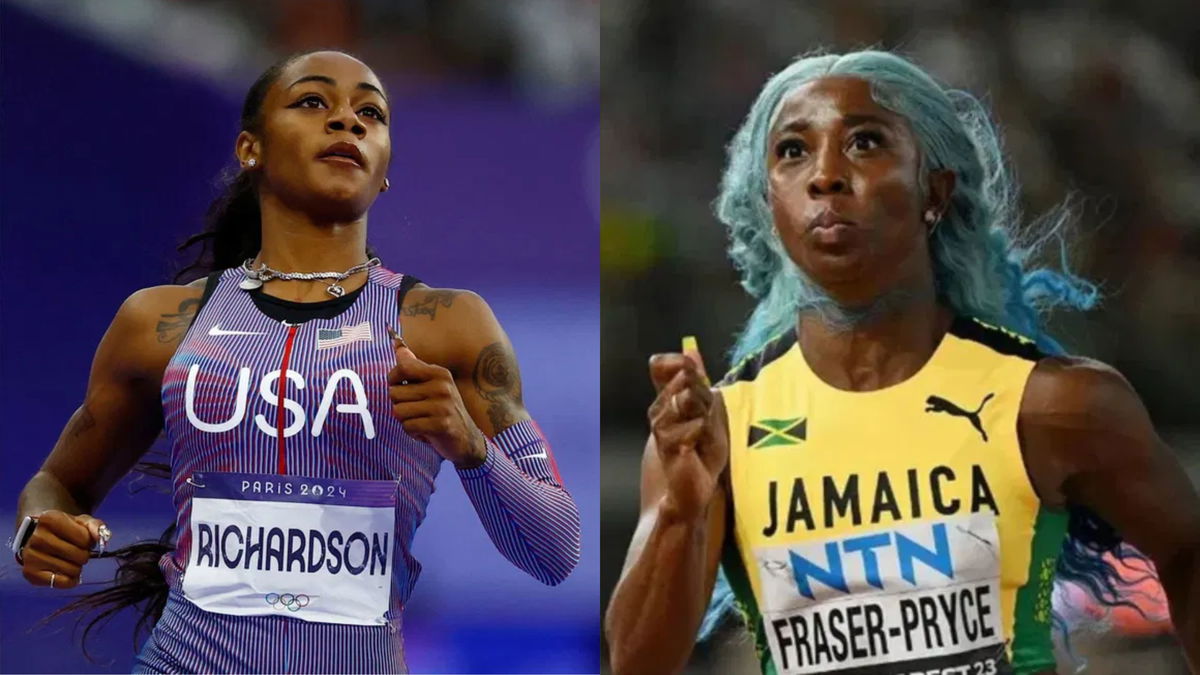
Imago
Credits: IMAGO

Imago
Credits: IMAGO
The Brussels Diamond League produced the kind of contest that track followers have long anticipated. Sha’Carri Richardson and Shelly-Ann Fraser-Pryce once again found themselves in the same starting blocks, renewing a rivalry that has carried across seasons and continents. The American and the Jamaican did not win the race, but their head-to-head carried its own intrigue. Melissa Jefferson-Wooden was the decisive victor in 10.76 seconds, yet the real talking point was Richardson crossing ahead of Fraser-Pryce, 11.08 to 11.17.
Watch What’s Trending Now!
For Richardson, this second-place finish represents more than a silver medal position. Her 2025 campaign has been punctuated by difficulties, beginning with an injury sustained in February that delayed her entry into competition. When she finally returned, her form was uncertain. She opened her year in Tokyo with a fourth-place finish at the Seiko Golden Grand Prix, clocking 11.47 seconds, her slowest time since 2021. Results continued to falter, including a ninth place at the Prefontaine Classic and a sixth at the Silesia meet. Off the track, her arrest for alleged domestic violence overshadowed her summer, forcing her withdrawal from the 100 meters at the U.S. Championships. Even though she returned for the 200, Sha’Carri missed the final.
This uneven run set the stage for Brussels. Against that backdrop, edging Fraser-Pryce mattered. Their rivalry stood at three wins each in prior meetings, and Friday’s outcome tilted the balance. Observers may argue that the clock was slow and the race lacked fireworks, yet within the broader narrative, Richardson’s finish ahead of her long-time opponent carried significance. After a series of disappointments, it suggested that she retain both resilience and belief.
ADVERTISEMENT
The rivalry itself has been a fascinating subplot in women’s sprinting. Richardson first rose to notice in 2019 with a 10.75 collegiate record before turning professional. That same year, she lined up against Fraser-Pryce at the Prefontaine Classic, both finishing outside the medals. By 2021, at the Muller Grand Prix, Richardson had already turned the tables, defeating the Olympic champion in both the heats and the final. Fraser-Pryce answered with three consecutive wins in 2021 and 2022, one of them in 10.65 seconds. Then in 2023, Richardson returned in peak form, taking the World Championship title in 10.65 while Fraser-Pryce earned bronze.

Imago
Sha’Carri Richardson/ Credits: Imago
The Brussels result, therefore, extends the storyline. Richardson was once again positioned to challenge, even if the stopwatch did not dazzle. For her fans, it was a moment of reassurance that she can still summon the composure to out-run one of the sport’s enduring figures. With the World Championships in Tokyo less than a month away, such an outcome may prove valuable for confidence.
ADVERTISEMENT
Meanwhile, Jefferson-Wooden’s victory should not be overlooked either. But the evening’s deeper resonance rested with two athletes whose careers have defined an era of sprinting. Richardson’s second place may not have carried a medal, but in the context of her year, and against Fraser-Pryce in particular, it carried weight that statistics alone cannot capture.
However, despite the fiery rivalry, Richardson has openly credited Shelly-Ann Fraser-Pryce as both her fiercest rival and one of her greatest sources of inspiration.
ADVERTISEMENT
Sha’Carri Richardson finds inspiration in her fiercest rival, Shelly-Ann Fraser-Pryce
Sha’Carri Richardson has never concealed the fact that her competitive fire is accompanied by genuine respect for one of the sport’s longest-standing figures. When she finally overtook Shelly-Ann Fraser-Pryce on the world stage back in 2023, she did not frame the moment as the defeat of an opponent but rather as the realization of a path she had long studied.
“She’s an amazing athlete. I grew up watching her,” Richardson admitted in Budapest before the 2023 Worlds, acknowledging that Fraser-Pryce’s career had shaped her own ambitions well before they shared the same starting line.
ADVERTISEMENT

Getty
BUDAPEST, HUNGARY – AUGUST 21: Sha’Carri Richardson of Team United States celebrates winning the Women’s 100m Final with bronze medalist Shelly-Ann Fraser-Pryce of Team Jamaica during day three of the World Athletics Championships Budapest 2023 at National Athletics Centre on August 21, 2023 in Budapest, Hungary. (Photo by Patrick Smith/Getty Images)
That acknowledgment was more than polite deference.
Top Stories
Calls Mount Against Patrick Mahomes for Ignoring Travis Kelce Amid Chiefs Offensive Struggles

Patrick Mahomes Pins Blame for Travis Kelce & Rashee Rice’s Costly Errors as Playoff Hopes Dwindle

Sean McVay Provides Health Update After Being Forced to Travel Away From the Team

Kyle Busch Hits Rock Bottom as Snowball Derby Nightmare Sparks Wave of Fan Sympathy

Browns Players ‘Mad’ at Shedeur Sanders for Costly INT as QB Asks for More Time to Improve

Chiefs QB Patrick Mahomes Firmly Pushes Back on Andy Reid’s Comments After Texans Struggles

Richardson explained that overcoming someone of Fraser-Pryce’s stature required her to reach a level she had not yet touched. “It was going to take my best to come forward and be able to compete, knowing that she’s been doing this and can continue to be on the podium every single time,” she reflected. The remark captured both the enormity of Fraser-Pryce’s consistency and the way that consistency compelled her rivals to raise their standards. In Richardson’s telling, the victory did not close a chapter but rather underlined how much further she felt she must go.
ADVERTISEMENT
Even within a rivalry that has already carried through the most prestigious stages, Richardson continues to present herself as both challenger and student. “It shows me that I have a journey. I have something to do. I have more to do,” she explained after her triumph. For her, Fraser-Pryce is not simply the competitor to surpass but also the example to measure against.
It is a rare balance: One athlete unwilling to yield and another unafraid to admit how much her own drive has been shaped by the one she now strives to eclipse.
ADVERTISEMENT
ADVERTISEMENT
ADVERTISEMENT

